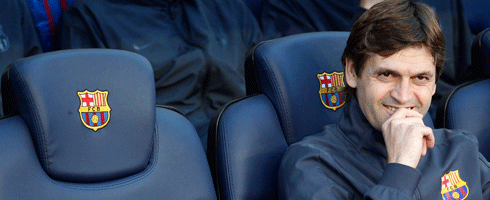Equalling Real Madrid’s record from 1991-92 season for the best start ever to a League campaign with 12 wins and one draw, one still cannot help but observe that this winning Barcelona are not as strong as in previous years. Possessing an aura of vulnerability that was once deemed unimaginable, Tito Vilanova himself has confessed of the need to improve.
Very little has changed from last season. The team are still devoted to the 4-3-3 formation whilst possession of the ball and control of the game are still key to their style. The difference lies in their movements both in midfield and in attack. Vilanova is keen to adopt a more direct approach to football, utilising the long ball more than they did before, as well as encouraging the passing to happen in the final third of the pitch.
Possession is there to bring results and unlike Pep Guardiola, who was fond of playing midfielders everywhere in the pitch, Vilanova plays with two forwards flanking Lionel Messi whilst Cesc Fabregas and Andres Iniesta have reprised their roles in midfield. Forwards are encouraged to look for space and allow themselves room to receive, which in turn has affected the manner in which the team defends.
Offensively, this is a far more capable side than what we have seen under Guardiola. Playing in a more direct manner, Vilanova’s side average 3.3 goals a match having scored 43 in 13 games. Should they continue in this manner, then they will have accrued 125 goals by the end of the season – that is four more goals than what Real Madrid broke records with last season.
However, as with every direct approach to football, control tends to be lost allowing for defensive fragility. Having conceded 15 goals in 13 games, Vilanova’s team on average allow 1.15 goals per game. Defensively, this is the worst Barcelona side we have seen in a decade. Under Guardiola, the club rarely allowed a greater average than 0.76 goals to be conceded a game.
It is perhaps this vulnerability at the back that has made this Barcelona side appear more mortal, less threatening and subsequently less formidable regardless of their consecutive wins accrued. That asphyxiating pressure we regularly associate with the side is not so accentuated under Vilanova. Forwards are uncovering space not recovering the ball allowing for more suffering at the back.
Due to the absences of Carles Puyol and Gerard Pique, Vilanova has tried more than seven different centre-back pairings in hopes of solving the problems at the back. When it comes to set pieces, the side suffer the most and Vilanova has acknowledged that their weakness in set pieces has much to do with the absence of the powerful Seydou Keita and Eric Abidal. Conceding four goals to Deportivo de La Coruna, this is the first time Barcelona has allowed the opponent to score this many goals against them in the League in three-and-a-half years.
With less pressure applied to recover the ball higher up the pitch, the back-line is subsequently more exposed often making for several individual errors at the back. This has already led to the concession of two own goals. This has only served to further enhance their fragility, robbing the side of that calm authoritative control they once exerted over their opponents.
Less sumptuous in their approach, there has been quite a bit of suffering attached to watching Barcelona play this season. With so many of their goals scored in the final stages of the match and after they’ve conceded, Vilanova has become adept at changing to a 3-4-3 shape when searching for goals to make for an even more direct approach that would in turn guarantee the positive result. Less Spanish and more Brazilian in style, player absences have contributed to Vilanova’s tactical decisions but if they are outscoring the opponent and accumulating never ending wins, surely they are still as formidable as ever?

